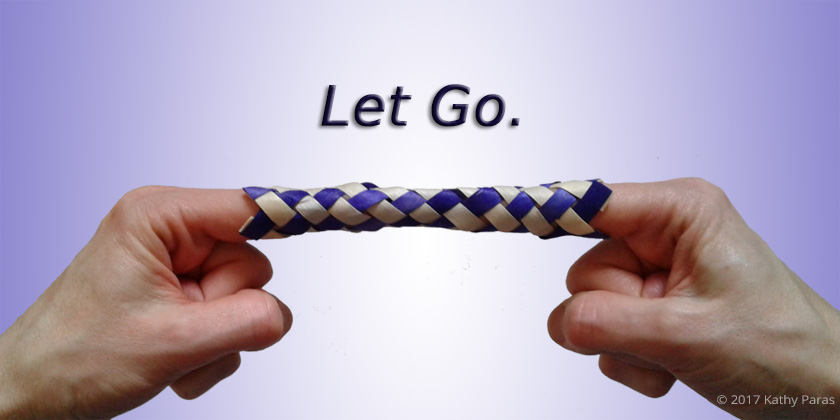Years ago, I learned a Taoist meditation called the Water Method*. Standing quietly, eyes closed, you bring your attention to your physical experience and learn to find, and eventually relax or “dissolve,” tension and blockages. The more you practice, the more deeply you begin to feel, physically as well as emotionally.
A while back, I took a moment to stand on my deck on a pleasant evening and try it again. I was out of practice and it took effort to stay focused. But after a few minutes, I found a knot of tension in my mid-upper back. It felt like a fist clenching several vertebrae together, making my breath shallow, making my posture slump. As I focused on that sensation, I felt it give slightly. Then, desperate for that relief, I started to stretch and pull and tense the muscles around that spot, as if I could wrestle my vertebrae from the clutches of that alien force.
And that quickly, I lost the little progress I had initially felt.
The harder you pull against a force that does not want to cooperate, the more it will strengthen its resistance.
The human body holds on to emotion, manifests it physically, in tense muscles or an upset stomach or a headache. The longer you ignore emotion you don’t want to deal with, the more it hardens into physical blockages in the body. It can curl your spine into a protective prison around your vulnerable insides, crease your brow, pinch your eyes, turn your mouth into a permanent frown.
The tension I had found was not a foreign object, an enemy to be vanquished. It was me. Part of me holding onto something. Containing it. Hiding it. Protecting myself from it.
As I breathed in and out and brought my mind back to my vertebrae, I chose to risk going deeper into that tension, trying to release whatever was clenched inside that fist, whatever I was protecting myself from. Again I felt the opening. My spine loosened. Breath rushed into my lungs. And a swell of emotion filled my face and eyes with the hot sting of tears. But I allowed myself to feel it. Just a little. And to appreciate the space it opened up in my back—a slight evaporation of tension I had lived with for so long it had become a part of me that I took for granted.
What might my life feel like if I could let all of those things go?
Tolerating and enduring is not all there is.
Life is a continual process of learning and letting go. Learning about life. Learning about ourselves. Letting go of experiences, possessions, beliefs. Of old hurts and emotional lock-boxes where we keep the things we don’t want to feel. Things we don’t want to be true.
Looking back I remember feeling much lighter the next day. Standing a little straighter. Breathing a little deeper. Just enough to notice. Enough to hold on to. Enough to believe that things can get better.
I can’t control what the world throws at me. But the darkness will surely last longer than it has to if I refuse look inside, understand what I’m clinging to, and let it go.
When you feel the darkness drag on and on and struggle to understand why you can’t seem to pull yourself out of it, into the light that others seem to experience, consider looking at what’s behind you. Are you holding yourself there, in the past? Holding on to something you don’t want to acknowledge or accept? Hiding it away in a lock-box that has turned into a straight jacket?
The only way it will ever stop anchoring you in darkness, is if you acknowledge it, allow yourself to feel it, and let it go.
*Susan Rabinowitz of the Taoist Arts Center in New York City teaches the water method. If you are in or near that area, I highly recommend her.




